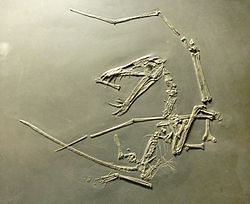1830 in paleontology
| List of years in paleontology |
|---|
| (table) |
Paleontology or palaeontology is the study of prehistoric life forms on Earth through the examination of plant and animal fossils.[1] This includes the study of body fossils, tracks (ichnites), burrows, cast-off parts, fossilised feces (coprolites), palynomorphs and chemical residues. Because humans have encountered fossils for millennia, paleontology has a long history both before and after becoming formalized as a science. This article records significant discoveries and events related to paleontology that occurred or were published in the year 1830.
Archosauromorphs
[edit]Crocodylomorphs
[edit]New taxa
[edit]| Taxon | Novelty | Status | Author(s) | Age | Unit | Location | Notes | Images |
|---|---|---|---|---|---|---|---|---|
| Aeolodon[2] | Gen. nov. | Valid | von Meyer | Kimmeridgian | Solnhofen Formation | A teleosaurid, named for Crocodilus priscus. | 
|
Pterosaurs
[edit]- Georg Wagler argued that pterosaurs represented a distinct class of aquatic vertebrates that he called Gryphi. Like Collini, Wagler thought that pterosaurs swam underwater using their forelimbs as flippers.[3]
New taxa
[edit]| Taxon | Novelty | Status | Author(s) | Age | Unit | Location | Notes | Images |
|---|---|---|---|---|---|---|---|---|
| Ornithocephalus banthensis[4] | Sp. nov. | Valid | Theodori | Toarcian | Posidonia Shale | Later renamed Dorygnathus banthensis | 
|
Other archosauromorphs
[edit]New taxa
[edit]| Taxon | Novelty | Status | Author(s) | Age | Unit | Location | Notes | Images |
|---|---|---|---|---|---|---|---|---|
| Protorosaurus speneri[2] | Gen. et sp. nov. | Valid | von Meyer | Guadalupian, 260–251 mya | Pirambola Formation | One of the most primitive archosauromorphs. Previously considered to be related to Prolacerta within Prolacertiformes, but now a new genus shows that they were in fact not closely related.[5] | 
|
References
[edit]- ^ Gini-Newman, Garfield; Graham, Elizabeth (2001). Echoes from the past: world history to the 16th century. Toronto: McGraw-Hill Ryerson Ltd. ISBN 9780070887398. OCLC 46769716.
- ^ a b von Meyer, H. (1830). "[eine Reihe von eigenhändigen Abbildungen von Reſten thierischer Organismen, begleitete mit Erläuterungen]". Isis von Oken. 23 (5–7): 517–519.
- ^ Wellnhofer, Peter (2008). "A short history of pterosaur research". Zitteliana B. 28: 7–19.
- ^ Theodori, C. (1830). "Knochen vom Pterodactylus aus der Liasformation von Banz". Frorieps Notizen für Natur- und Heilkunde. 632: 101.
- ^ Borsuk–Białynicka, M.; Evans, S.E. (2009). "A long–necked archosauromorph from the Early Triassic of Poland" (PDF). Palaeontologia Polonica. 65: 203–234.